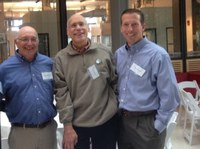Three Penn State Meteorology alumni are recognized for hurricane model development

Robert Tuleya, Morris Bender and Tim Marchok
For more than 45 years, research scientists at GFDL/NOAA along with their collaborators at external institutions have made seminal contributions to the science in numerous areas related to regional hurricane model development. These contributions not only led to the success of the GFDL hurricane model as an operational forecasting tool, but also played a part in laying the foundation for later hurricane modeling efforts both within and outside of NOAA.
Three Penn State Meteorology Department graduates: Morris Bender (1976,MS); Tim Marchok (1994,MS); and Robert Tuleya (1969,BS, 1971,MS) played dominant roles in the GFDL Hurricane Model development and maintenance. After over 22 years, the GFDL Hurricane Model, which has served as an operational forecasting tool for the National Weather Service since 1995 and the U.S. Navy since 1996, is being retired from operations this year. In May, a symposium afforded the opportunity to review the body of research centered around the development and use of the GFDL hurricane model and to share some of the latest advancements in hurricane science from GFDL and the research community. https://www.gfdl.noaa.gov/gfdl-hurricane-science-symposium/
In addition, Bender, Marchok, and Tuleya, together with colleague Isaac Ginis of URI, received a certificate of appreciation in Spring of 2017 from Louis Uccellini, NOAA NWS Director and Craig McLean, NOAA/OAR Director for making ‘significant improvements (to the model) over its lifetime’ and ‘significant advancements in the numerical modeling of hurricanes, with tremendous societal benefits.’
